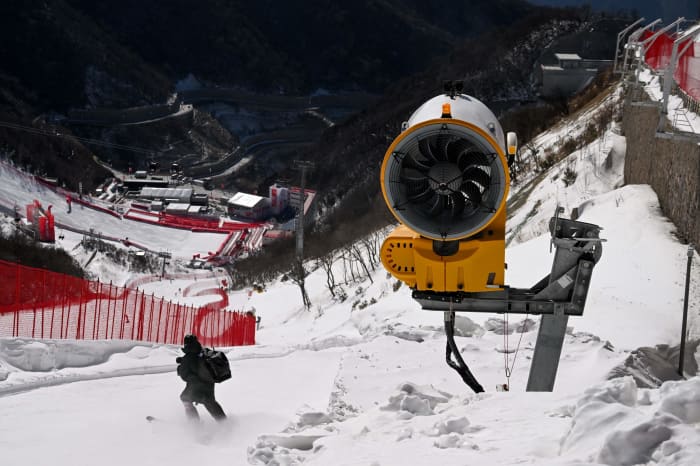Joel Mathis, Contributing Writer
Mon, February 7, 2022,

Jane Fonda and Tucker Carlson. Illustrated | AP Images, Getty Images, iStock
For most of my life, the anti-war movement — such as it is — has been a primarily left-of-center phenomenon.
When you think of the Vietnam War, images of hippies, Jane Fonda and Eugene McCarthy probably come to mind. The "nuclear freeze" campaign of the 1980s was similarly a lefty occurrence. When President George W. Bush prepared to launch the invasion of Iraq in 2003, it was mostly liberals and leftists who took to the streets in protests — and when Americans got fed up with that misbegotten war, they elected Democrats to put an end to it. (That didn't work out quite as well as hoped.) Donald Trump may have negotiated the U.S. withdrawal from Afghanistan, but it was Joe Biden who completed it. There have been paleoconservative exceptions to the rule, and the Democratic Party isn't exactly filled with peaceniks, but the hawks-versus-doves clash in this country has largely been a right-against-left conflict.
Now Russia appears to be on the cusp of invading Ukraine — Jake Sullivan, the national security adviser, warned Sunday that war could come within days — and some of the loudest voices for U.S. restraint are coming from conservatives. It's kind of weird!
There's Sen. Josh Hawley (R-Mo.), arguing that the U.S. should make clear that Ukraine will never be allowed to join NATO. There's Tucker Carlson, delivering nightly screeds against U.S. involvement in the standoff on Fox News. And there's a vocal group of fresh-faced Trumpist politicians who are following Carlson's lead, echoing his arguments against intervention as they run for office. A generation of GOP hawks seems uncertain how to handle the moment.
That's led some observers to wonder if there might be a natural alliance between those elements on the left and right urging U.S. restraint in Eastern Europe. "If Ukraine joined NATO, the risk would increase," my colleague Jim Antle pointed out last month. "Could populists and progressives work together to stop it?"
Maybe. But there are a few reasons antiwar progressives should be cautious, at the very least, about making common cause with the Trumpist right:
The xenophobia: Carlson's opposition to aiding Ukraine is rooted — rhetorically, at least — in his longstanding inability to tell the difference between immigration and an actual military invasion. It's a chance to knock "open borders" Democrats. Why would we protect Ukraine's borders and not our own?
For Carlson, this is an explicitly racial question, cast in typically bad-faith terms. "Doesn't immigration increase diversity, the blessed source of all beauty, power, and strength? Well, sure, most of the time it does, but not in Ukraine," he said in a recent commentary. "People who look or speak differently, people from other places with, say, different religions, are not allowed in Ukraine, period. That's Nancy Pelosi's position. Ukraine is the one place Nancy Pelosi very much wants to keep racially pure." Carlson once rooted on the Iraq War by calling Iraqis "semi-literate primitive monkeys." His stance on U.S. force has evolved over the years; his racism hasn't.
The culture war weirdness: Conservative writer Rod Dreher has a longstanding history of skepticism regarding U.S. war-making: He was an early defector from the movement's near-monolithic support of the Iraq War. Since then, though, he has become shrilly obsessed with "wokeness" and LGBT issues, and has become one of the leading voices in the right's embrace of Hungary. The current standoff is no exception to that trend — Dreher believes American opposition to a Ukraine invasion stems from anger over Vladimir Putin's opposition to gay rights.
"This cold war with Russia is an extension of the culture war within American society, waged by elites against the American people," Dreher wrote in his blog at The American Conservative. That reading might be the product of Dreher's particular passions, but maybe not. Much of the right, after all, sees Putin as one of the world's leading defenders of Christendom.
The militarism: Hawley isn't really being dovish when he argues against Ukraine's entry into NATO. He just doesn't want America to divert its attention away from a possible confrontation with China. That's where the real action is. "The United States can no longer carry the heavy burden it once did in other regions of the world — including Europe," he recently wrote to Secretary of State Antony Blinken. "To the contrary, we must do less in those secondary theaters in order to prioritize denying China's hegemonic ambitions in the Indo-Pacific."
None of this is the humanist pacifism of, say, Martin Luther King Jr. or Daniel Berrigan. It's something darker, uglier, and angrier. That's unsurprising; the "America First" anti-war activism of Charles Lindbergh, for example, was inextricable from his anti-Semitism. Something similar was at play when Patrick Buchanan launched The American Conservative on the eve of the Iraq War. "For all its newfound pacifism," the writer Sam Tanenhaus noted at the time, "the 'Buchananite' worldview remains a bully's, more authoritarian than libertarian, its favorite targets minorities, the poor, and the weak." That's still true.
That doesn't mean that the anti-war left shouldn't work with whatever allies they can find. The goal of those who advocate American restraint should be to avoid a war with Russia, not to signal their own virtue. But they should tread carefully. The world that Tucker, Hawley, and the rest hope to create is very different from the one progressives want.











